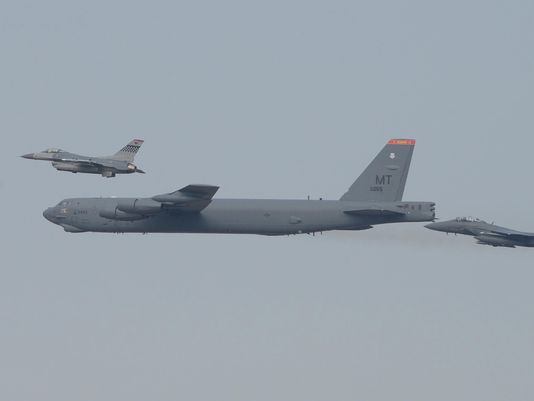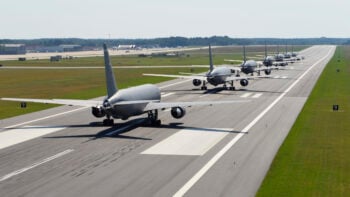The modernization of America’s nuclear weapons looms as one of the largest and most crucial set of strategic and spending decisions the American military faces over the next decade. A crucial element in this discussion is how does America best prove it can deliver these weapons — without annihilating certain portions of our globe — and thus influence the behavior of our competitors and enemies. At Breaking Defense we’ve been honored to host a robust debate on the meaning of deterrence, whether it works, how it works and how it might best be enforced. The new Long Range Strike Bomber, which the Air Force has unfortunately named the B-21 instead of the B-3, is perhaps the most controversial part of that debate right now because it’s in the early stages of development. In the last of the exchanges between Adam Lowther, director of the Air Force’s School of Advanced Nuclear Deterrence Studies, and former Los Alamos nuclear expert, Jim Doyle, about the bomber, Lowther offers a detailed defense of the bomber. I hope our contributors will keep hammering away at the issue of deterrence and how to effect it. Read on. The Editor.
In response to our recent Breaking Defense article, “Why Bombers Are Key to Nuke Modernization; Think Russia, North Korea, China,” Jim Doyle both mischaracterizes our argument and conflates unsubstantiated assertions with causal evidence. In attempting to discredit our premise that nuclear capable bombers and their weapons should be modernized because they remain a critical part of America’s nuclear deterrent, Doyle uses the age-old debating tactic of obfuscation — changing the subject — to create a straw man argument.
He begins by asserting that American bombers failed to prevent the Kim regime from testing its nuclear weapons and ballistic missiles. As we did not argue in our article that bomber presence missions could achieve this objective, this criticism is irrelevant.
Doyle then claims that bomber missions have “done nothing to ease tension on the Korean peninsula or improve North Korean behavior.” It is simply false that America’s deterrent flights have not eased tension on the peninsula–though as we noted, this form of deterrence is not a one-time action but a constant, ongoing effort. Furthermore, tensions would clearly be far higher if the United States ignored North Korean provocations. The second part of his statement is irrelevant, because we did not argue that bombers could improve North Korean behavior–and this is emphatically not the responsibility of the American bomber force.
 According to Joint Publication 3.0 deterrence is: “The prevention of action by the existence of a credible threat of unacceptable counteraction and/or belief that the cost of action outweighs the perceived benefits.” It is worth noting that the United States has never threatened North Korea with military action should the Kim regime develop or test a nuclear weapon or an intercontinental ballistic missile.
According to Joint Publication 3.0 deterrence is: “The prevention of action by the existence of a credible threat of unacceptable counteraction and/or belief that the cost of action outweighs the perceived benefits.” It is worth noting that the United States has never threatened North Korea with military action should the Kim regime develop or test a nuclear weapon or an intercontinental ballistic missile.
Doyle believes that unless North Korea refrains from developing, building, and testing such weapons, then the American bomber force “doesn’t work.” To coerce North Korea in this fashion would require nothing less than a credible threat to go to war – a threat no president has been prepared to make for over 20 years. Thus, Doyle is criticizing the bomber force for failing to execute a policy that is not President Obama’s policy or that of his predecessors. Such a critique is meaningless.
In fact, the strongest threats the United States has issued against such developments include sanctions and the Six Party talks. Counter to Doyle’s argument, diplomacy on the Korean peninsula has proven an abysmal failure and, counter to his argument, has actually emboldened North Korea.
Should the United States threaten to send nuclear bombers to attack North Korea —and then fail to carry out the threat — Doyle would have a point. Until such a step is taken, using bombers to assure South Korea and deter North Korea (from attacking South Korea) it is difficult to argue that nuclear capable bombers are failing to achieve their mission.
It is also worth noting that the most important aspect of the assurance and deterrence mission American bombers are performing—at present—is assurance to South Korea that the United States has the resolve to use nuclear weapons against North Korea should the necessary circumstances arise.
It would be unwise to forget that South Korea only revealed the existence of its secret nuclear weapons research program (1970-1984?) in 2004. While President Park Geun-hye remains formally committed to the Nuclear Non-proliferation Treaty, a 2013 survey of South Koreans found that 66 percent of respondents support an independent nuclear weapon capability for South Korea. This survey, and more recent research, finds that South Korean confidence in the American nuclear umbrella is wavering.
Should American assurance fail in Korea and its government choose to pursue an independent nuclear deterrent, the region would become be a much more complicated place. Contrary to Doyle’s argument, flying nuclear capable bombers over South Korea plays an important role in tamping down calls for the South – not to mention Japan and Taiwan – to develop their own nuclear weapons and delivery systems.
He makes a similar mistake in offering Russian aggression in Ukraine as an example of how nuclear capable bombers are not an effective signaling tool in American deterrence policy. Doyle again suggests that the United States has attempted to coerce Russia, It has not. President Obama has never stated or even implied that an American attack is imminent unless Russian forces leave Ukraine.
Thus, when the United States sends nuclear-capable bombers to the United Kingdom, it is a signal that the United States supports a NATO member—not a country outside NATO and its Article 5 mutual defense requirement. One reason to provide this assurance is that Russian nuclear bombers regularly approach British airspace. Evidently, President Putin does not agree with Doyle’s view that such nuclear signaling has no value.
Doyle’s claim that efforts to influence adversaries with nuclear “signals” have always been ineffective is flatly wrong. A 2013 RAND study examined dozens of historical crises, and showed that bombers are the most stabilizing and effective way to send political signals. More recently, Georgetown professor Matthew Kroening found that nuclear weapons are a highly effective way to issue coercive threats, especially when wielded by a state with nuclear superiority.
Doyle completely misunderstands the 1969 Strategic Air Command alert. He believes the United States launched this alert to persuade the Soviets to pressure North Vietnam to accept American peace terms, and that this effort failed. In fact, the United States put its nuclear forces on alert in late 1969 in order to deter the Soviets from attacking China.
Over the course of 1969, Sino-Soviet border clashes had escalated to the brink of war, and the Soviets asked the United States to remain neutral during a Soviet nuclear attack on China. Nixon not only refused, but threatened an American nuclear attack on the Soviets if they attacked China, backing this threat with bomber flights on the Soviet periphery. Chinese sources confirmed this version of events and the decisive success of Nixon’s 1969 nuclear signaling.
The value of nuclear capable bombers for nuclear signaling is perhaps best exemplified by the Cuban Missile Crisis (October 16-28, 1962). What too few Americans know about the events that transpired during the crisis is that Gen. Thomas S. Powers, leader of Strategic Air Command, moved large numbers of nuclear bombers to Air Force bases in the Southeast, completely filling parking ramps with the very bombers that were set to attack Cuba with nuclear weapons should the order be given. Soviet intelligence was aware of this move. This signal, combined with credible American preparations to invade Cuba, prompted the Soviets to withdraw their missiles from the island.
When examined in light of actual American policy – rather than what Doyle mistakenly believes American policy to be – the value of the bomber force for sending political signals is clear and convincing. There is also a long historical track record that demonstrates the efficacy of nuclear threats and deterrence signals, including open admissions from our former adversaries that our threats influenced their decisions. Taken together, all this indicates that it is essential for the nation to modernize its nuclear forces and maintain its superiority in advanced bomber technology.
Adam Lowther is director of the School of Advanced Nuclear Deterrence Studies.The views expressed in this article are those of the author and do not necessarily reflect the official policy or position of the Air Force, the Defense Department or the U.S. Government.
Army inching towards late FY25 Chinook Block II full-rate production contract
Boeing recently announced the Block II helo’s first maiden flight and plans to deliver the first production aircraft to the service in the coming weeks.



























